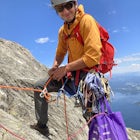Hike to the Summit of Phelps Mountains
Lake Placid, New York
Details
Distance
8 miles
Elevation Gain
2100 ft
Route Type
Out-and-Back
Description
Added by Justin Dong
Phelps Mountain is an easy hike in the heart of the Adirondack High Peaks with fantastic views all around.
The hike starts at Adirondack Loj in the High Peaks Information Center parking lot. From there, follow the signs for Phelps Mountain/Mt. Marcy. The trail to Phelps Mountain follows the Marcy trail for the first three miles.
The first two miles to Marcy Dam are relatively flat, with the elevation gain picking up in the next mile after. The trail will eventually cross Phelps Brook. In early winter, when the brook hasn't frozen over enough yet, you can cross at the high water bridge (about a quarter of a mile before the foot crossing, and well-signed). Otherwise, the regular foot crossing is fine once winter sets in or in summer months if the water level isn't too high.
After third mile, you will come to the Phelps Mountain junction. From here, it's one mile to the summit. Be aware though, that most of the elevation gain is in the final mile.
In the winter, bring microspikes or crampons. If snow accumulation is 8 inches or more, it is a requirement in the High Peaks Wilderness to have snowshoes with you AND wear them. You can and will be fined by a ranger if you don't have them! The final mile can me very icy at times, so traction devices are essential.
The view at the summit is phenomenal, with nearby Algonquin Peak, Mt. Marcy, and Colden Mountain being right in front of you.
Download the Outbound mobile app
Find adventures and camping on the go, share photos, use GPX tracks, and download maps for offline use.
Get the appFeatures
Hike to the Summit of Phelps Mountains Reviews
There are better hikes in ADK but this is nice if you have done the big ones. There are not as many views on this, but once you get to the top you have some looking south.
3.0
Leave No Trace
Always practice Leave No Trace ethics on your adventures and follow local regulations. Please explore responsibly!
Nearby
Hike Algonquin Peak
Hike to Street and Nye Mountains
Hike Phelps and Tabletop Peaks
Hike to Mount Colden via Avalanche Pass
Great Range Traverse
Hike Wright, Algonquin, and Iroquois Mountains
Community
© 2024 The Outbound Collective - Terms of Use - Privacy Policy










